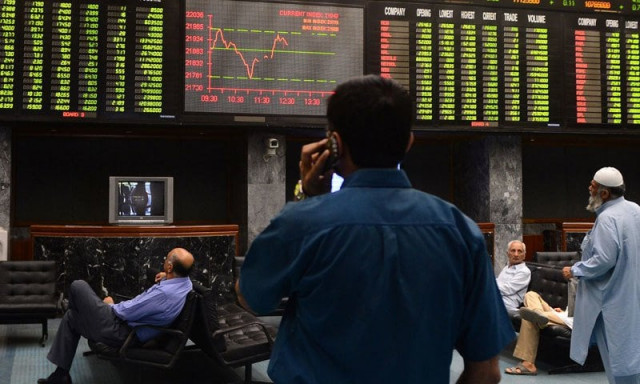Business
Other side of multinationals’ exit story | The Express Tribune

As some long-entrenched firms leave, new players move in, drawn by signs of economic recovery and growth
Also likely to levy income tax on companies suffering gross losses. PHOTO: NASDAQ
ISLAMABAD:
“All happy families are alike; every unhappy family is unhappy in its own way.” Leo Tolstoy
Procter & Gamble’s exit from Pakistan has reignited debate over the country’s business climate. Many view it as part of a broader trend of multinational companies leaving amid mounting economic challenges. Analysts have pointed to high corporate taxes, restrictions on profit repatriation, and a cumbersome regulatory environment as key reasons. But the story is more complex.
Over the past four years, nine multinational companies have exited or divested their operations in Pakistan. Four of these were manufacturers – three pharmaceutical firms (Pfizer, Sanofi-Aventis, and Eli Lilly) and one consumer goods company (P&G). The remaining were service-sector players such as Shell, Total, Telenor, and Uber/Careem. The pharmaceutical sector has seen the most exodus; though this is not new. Three decades ago, 48 multinational drug companies operated in Pakistan. Today, fewer than half remain. Most have gradually divested, transferring operations or product registrations to local firms that now command over two-thirds of the domestic market.
Price controls and rigid regulations have made it harder for global firms to operate profitably, while local players have grown stronger, more agile, and more competitive.
P&G’s decision appears to reflect its global priorities more than Pakistan’s domestic conditions. Its strategy now centres on manufacturing in major markets like the United States, Europe, Greater China, and India, while exiting relatively smaller markets including Nigeria, Argentina, Bangladesh, Kenya, and others in Latin America.
In the services sector, exits also reflect broader global restructuring rather than a loss of investor confidence. Shell’s sale of its Pakistan operations to Saudi-based Wafi Energy aligns with its strategy to exit retail fuel businesses in several countries. Telenor’s decision, taken in 2022, is part of a move to focus on a smaller set of core markets. Uber and Careem have yielded market share to more affordable competitors such as InDrive and Yango. As some long-entrenched firms leave, new players are moving in, drawn by signs of economic recovery and growth. China’s Challenge Group is investing $150 million in Punjab to develop a high-tech textile zone expected to generate 18,000 jobs and an estimated $100 million in apparel exports.
Consumer healthcare multinational company Haleon is expanding its Jamshoro facility, positioning Pakistan as a regional manufacturing hub and targeting a sizeable part of production for export. Belarus plans to set up a tractor manufacturing joint venture in Balochistan.
In the financial sector, the sale of First Women Bank Limited marks the first successful privatisation in two decades. Though a small transaction, the acquisition by a multibillion UAE investment holding company signals growing investor interest as it explores more opportunities in Pakistan. UAE’s Mashreq Bank is also investing $100 million, aiming to expand financial access for the unbanked and establish Pakistan as a back-office hub for its global operations.
The largest new wave of investment is expected from China as both countries resume work on the long-delayed second phase of CPEC. New investments amounting to $8.5 billion, including $1.5 billion in joint ventures, have recently been finalised, targeting key sectors such as agriculture, renewable energy, electric vehicles, healthcare, steel, and other emerging industries.
It is essential that these new investments do not repeat the old import-substitution model pursued by many existing companies. Instead, they should emulate the example of the Chinese-Pakistani joint venture, Service Long March (SLM) Tyres, which has successfully captured most of the domestic market once dominated by smuggled goods and is now exporting tyres worth $100 million annually, mostly to the United States.
The real challenge for policymakers is to identify and replicate such success stories. Pakistan hosts over 200 multinational companies that play a vital role in driving commerce and industry and contribute more than one-third of the FBR’s total tax collection. Yet, despite this significant presence, their export footprint remains negligible, even as they repatriate over $1.5 billion in profits annually.
In contrast, multinationals operating in other developing countries are far more outward-looking, focused on global markets, earning substantial foreign exchange, and contributing to export growth rather than relying primarily on domestic sales.
The recent reforms to Pakistan’s trade and tariff policies offer an opportunity to shift towards export-led growth, and multinationals can and should play a central role in that transition, as they have elsewhere.
The era of special concessions through SROs and high tariff protection is drawing to a close. Companies can no longer afford to depend on importing components at low duties, assembling them, and selling locally at high margins in a highly protected market.
To remain relevant and competitive, they must break this cycle of dependency and embrace an export-oriented strategy, one that rewards efficiency, innovation, and global competitiveness. This is precisely how the East Asian economies transformed their industrial landscapes and achieved lasting prosperity. By following similar policies, Pakistan can do the same.
The writer is a member of the steering committee overseeing the implementation of the National Tariff Policy 2025-30. He has previously served as Pakistan’s ambassador to the WTO and FAO’s representative to the United Nations
Business
Thames Water halts plans to hand £2.5m retention bonuses to bosses

Thames Water has decided not to go ahead with almost £2.5 million in controversial payments to senior bosses.
The debt-laden utilities giant faced a political outcry over plans to hand out the money.
Thames Water was expected to hand £2.46 million to 21 senior executives in so-called retention awards to encourage them to stay with the business.
However, the company has deferred this until further notice following talks between directors in recent days.
The deferment, which was first reported by Sky News, comes after the 21 executives received a previous £2.46 million worth of payments earlier this year.
Chris Weston, Thames Water’s chief executive, was not among those set to receive a bonus and is already the subject of a bonus ban from industry regulator Ofwat.
Thames Water has declined to comment.
Alistair Carmichael, chairman of the Environment, Food and Rural Affairs Select Committee, contacted the company in recent weeks raising concerns over the plans for further payments and asked for confirmation about whether the money would be handed out.
On Tuesday, he said: “It’s important that the focus of Thames management is on turning round the company and not on rewarding staff and having to handle negative headlines.
“The public is rightly furious at the prospect of senior staff in a company with the performance record of Thames receiving bonuses.
“We will continue to monitor this situation.”
It comes a fortnight after Thames Water said it was still locked in talks over its proposed rescue with creditors.
Britain’s biggest water supplier, with around 16 million customers, said discussions were “positive” but ongoing with the Government and regulators to agree a deal to turn around the firm and repair its stricken finances.
Half-year results from the provider revealed underlying earnings surged to £1.2 billion for the six months to September 30, compared with £715.1 million a year ago.
Revenues rose by 42% thanks to bill increases, which it said also helped fund £1.3 billion of capital investment to fix leaks, cut sewage spills and improve water quality.
Business
Startup backed by Altman, JPMorgan announces capital lending partnership with Amazon

Slope, a lending startup that uses artificial intelligence to vet businesses, is partnering with Amazon starting Tuesday to provide a reusable line of credit to Amazon sellers, backed by a JPMorgan Chase credit facility, the company told CNBC exclusively.
The new relationship means eligible U.S. Amazon vendors can apply for and access capital directly through their Amazon Seller accounts with real-time approvals.
Slope was co-founded by CEO Lawrence Lin Murata, who said said he saw the ups and downs of running a small business while he was growing up in São Paulo.
Lin Murata helped his parents at their family’s toy shop, which they’ve been running for more than three decades. As he gained more insight into the finances of the business, he said he realized that cash flow was a large pain point for his parents and other small businesses.
That led him to start Slope, an AI-powered lending platform backed by OpenAI CEO Sam Altman and JPMorgan Chase, with co-founder Alice Deng.
“Leveraging AI, we’re able to underwrite these businesses, and we’re able to handle all the complexity of assessing the risk for a business,” Lin Murata said. “At the same time, [we’re] providing a very easy, real-time experience to them.”
The lines of credit will start at an 8.99% APR, according to Slope, and require vendors to be in business for at least one year with more than $100,000 in annual revenue. Once approved, Amazon sellers can draw from the line as needed and choose a term ranging from three months to a year to align repayment with their inventory cycle. Scope did not disclose the financial aspects of its deal with Amazon.
“Most people don’t realize that sellers, independent sellers, are kind of the backbone of Amazon and e-commerce in general,” Deng told CNBC. “More than 60% of Amazon’s sales are driven by independent sellers.”
Deng said Slope is filling a gap with the new partnership. Currently, Amazon sellers can use some third parties to access capital, though Deng said those initiatives are more focused on smaller sellers, while Slope is focused on mature sellers, some of whom reach hundreds of millions of dollars in revenue and require bank-grade financing.
Deng said when Amazon did its own lending around four years ago, the total addressable market was between $1 billion and $2 billion. With Slope taking over the program, the company expects that number to grow.
“We’re excited about our work with Slope, which expands the financing tools available to Amazon selling partners,” an Amazon spokesperson told CNBC. “Whether they are just starting out or looking to grow, access to sufficient capital is a critical need for small business owners, and we’re always evaluating new ways to empower sellers to thrive in the Amazon store.”
With Slope’s new deal, sellers can take a few minutes directly on Amazon Seller Central to apply for capital and get approved almost instantly, using proprietary Amazon performance data and Slope’s in-house large language model, Lin Murata said.
“That is one of the reasons why we’re able to give a more compelling offer than if you were outside of the Amazon dashboard,” Lin Murata said. “And then we give real-time decisions, so we analyze Amazon performance, data, and cash flow in real time.”
It’s a process that the Slope co-founders said is easier, faster and more integrated than having to apply for loans at banks as a small business. With the granular data that Amazon provides, like a breakdown of sales by product, they said the AI model is able to make a more informed decision on financing than a bank would based on overall financial documents.
With the new deal, Amazon joins a growing slate of Slope’s customers, which already include Samsung, Alibaba, Ikea and more.
Deng and Lin Murata said the company has trialed the new Amazon integration, and though the trial has been live for just a few weeks, the pair said it’s seen significant demand and applications growing 300% week over week.
“Going back to the initial inspiration of my parents, I think we want to be the credit intelligence layer for these businesses,” Lin Murata said. “Ultimately, what we’re really doing is helping these businesses grow by giving them fair, affordable, fast and very easy access to different forms of financing.”
Business
Wessex Water to pay £11m towards wastewater upgrades after Ofwat investigation

Wessex Water will pay £11 million toward upgrades after the industry watchdog found it failed to properly manage its wastewater network.
The water company, which serves around 2.9 million customers in the South West, was made to pay the enforcement package by regulator Ofwat.
By agreeing to the extra investment in its network, the firm avoids having to pay a fine.
It will be paid for by shareholders and not through customer bills, the watchdog confirmed.
Wessex Water failed to operate, maintain and upgrade its network to ensure it could cope with flows of sewage and wastewater, Ofwat found in its investigation.
The investment package will go towards a series of upgrades, including helping private landowners to seal their sewer pipes to avoid unnecessary groundwater reaching its network, and bringing forward investment into reducing spills at specific storm overflow areas.
Money will also be spent on installing monitoring equipment and helping customers to sustainably manage rainwater at their properties.
Ofwat said Wessex was the sixth case it had completed in its wider wastewater investigation, which has resulted in £250 million in fines and enforcement packages.
Lynn Parker, senior director for enforcement at Ofwat, said: “These cases are a crucial part of holding water companies to account and driving the transformation of the water sector that the public wants to see.”
Wessex Water had said it “regrets the impact our wastewater performance has had on customers and the environment”.
The company said the investment package “will tackle the problem directly” and that it was planning to invest £300 million in its sewerage infrastructure by 2030.
-

 Politics1 week ago
Politics1 week agoThailand launches air strikes against Cambodian military: army
-

 Politics5 days ago
Politics5 days agoTrump launches gold card programme for expedited visas with a $1m price tag
-

 Politics1 week ago
Politics1 week agoZelenskiy says Ukraine’s peace talks with US constructive but not easy
-

 Fashion1 week ago
Fashion1 week agoGermany’s LuxExperience appoints Francis Belin as new CEO of Mytheresa
-

 Tech7 days ago
Tech7 days agoJennifer Lewis ScD ’91: “Can we make tissues that are made from you, for you?”
-

 Business6 days ago
Business6 days agoRivian turns to AI, autonomy to woo investors as EV sales stall
-

 Entertainment1 week ago
Entertainment1 week agoToo big to fail? IndiGo crisis exposes risks in Indian aviation
-

 Sports6 days ago
Sports6 days agoPolice detain Michigan head football coach Sherrone Moore after firing, salacious details emerge: report










